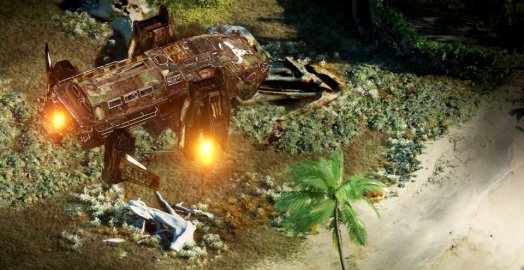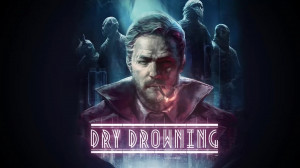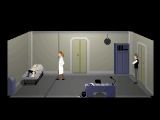Review for Beautiful Desolation

With their well-received sci-fi debut STASIS in 2015, The Brotherhood set a high bar for their next project. With Beautiful Desolation, the indie South African developer led by Nic and Chris Bischoff maintains the slick isometric presentation style of its predecessor but takes quite a thematic left turn, leaving behind the isolation of space horror in favor of a more fantastical foray into a distant future in which many strange new races populate Earth. Though the end result at times over-relies on backtracking and finnicky pixel-hunting over the course of its generous 15-20 hour runtime, it is nonetheless another imaginative point-and-click adventure with excellent production values and strong characterizations that is cerebrally engaging throughout.
The game centers on Mark and Don Leslie, two brothers who have grown a bit distant after an uneasy childhood and the demands of adult life. As the story opens in 1970s Cape Town, Mark and his fiancée Charlize are on their way through a heavy downpour to bail the older Don out of his latest trouble when a violent shockwave catches their automobile in its wake, injuring Mark and costing Charlize her life. This marks the arrival of the alien ship Penrose on Earth, bringing with it untold advancements in technology and changing life on the planet forever. A moment later, we’re flashed forward ten years when Mark enlists Don’s aid to board the mysterious craft that caused him such grief. During the attempt, however, they are cornered by the ship’s security system and unceremoniously swept into the distant future through a sudden pulse. Now, with modern human civilization long gone and the Earth populated by brand new biological and technological societies, the two siblings, along with their talking robot canine Pooch, must find a way to travel back to their own time.
All of this happens within the game’s first 10-15 minutes, quickly yanking players out of their comfort zone. The jarring feeling of being a lost traveler in an unknown land doesn’t abate, either, as new races and locations are uncovered at a constant clip throughout the game. After acquiring a flying transport called the Buffalo early on, Mark, Don and Pooch will gain access to new map areas dotted around a future version of South Africa that has seen nature reclaim much of what was once populated. Connected by travel gateways called Wardens, each of these areas hosts several unique species that the trio must meet, interact with, and agree to help in exchange for components that will let them power the ancient technology needed to return to the Penrose and – hopefully – home.
For the most part, Beautiful Desolation’s world has been split into distinct settings in which self-contained storylines play out between the two or three factions native to that region. For example, the mutated Fley with their head tentacles – a result of their symbiotic relationship with the Brissel Worms that are introduced to their bodies via their ear canals at a young age – live close to the humanoid Mongrel tribe, whose young they harvest to bond with more Brissel Worms. Then there is the Nest, sentient nanomachines that exist in close proximity to the Moss, a race of plant creatures whose existence is threatened by the Nest’s expansion. All told, there are six areas to uncover little by little, and you’ll return to each of them a great many times over the course of the game.
In order to acquire items needed to advance, in most cases the brothers must solve the conflicts in each district, ultimately siding with one competing species or the other. There are a good number of new creatures to discover, and several ways in which to resolve their problems. For instance, both the Fley and the Mongrel require an ancient superweapon in order to wipe out the other. Once the weapon is attained, you can choose whom to deliver it to, predictably dooming the less fortunate side to certain death. Elsewhere, a battle arena is plying its trade using slave warriors from all regions, letting you either participate in its bloody battles in a tactical combat mini-game – one of two such side activities available – or abstain altogether and even mete out punishment to the slavers themselves later on. Nothing is forced on the player, and all paths lead toward the game’s ending; even terminating the existence of one or more species is accounted for in the finale.
With so many alien cultures represented, the game really does make you feel like a fish out of water right from the very beginning. Even before civilization crumbles, the initial setting with its heavily accented voice actors adds to that feeling of complete unfamiliarity (at least for those of us not native to the country). But beyond the intentional culture shock lies the equally uncomfortable issue of not being able to find one’s place in the far-off future. Terms and important events are tossed around cavalierly, without the proper context. Who’s Daris? What’s the Ascendancy? Even the true origins of the Penrose itself remain a mystery.
Each alien race only has a couple of voiced representatives to interact with, and a handful of lines of dialogue just aren’t enough to get a good sense of the history that’s quickly skipped over during the time jump. While that’s at least partly understandable – Mark and Don would also be quite overwhelmed at first, after all – a bit more depth is really needed to let players make some connections with this strange new world. As it stands, there’s lots to see and marvel at, but it’s glossed over so superficially that it’s difficult to care about much of it, and the environmental flavor text just serves to describe what’s plainly in front of you.
An exception to this, thankfully, is the relationship between Mark, Don and Pooch, which gets a well-written treatment over the course of the game. The brothers’ childhood is explored, as is the death of Charlize and how it further forced a wedge between them, while Pooch goes through the existential crisis that sentient machines always seem to suffer from in such stories. The trio’s struggles become enough of a focal point to make the protagonists quite likeable without stealing the spotlight from the main narrative.
Being able to have a hand in how their relationships evolve via dialog choices is a nice touch as well, and there are unique endings depending on how the three have gotten along with each other. Conversational options also exist in many of your interactions with other characters, so you can choose to have Mark – whom you directly control while the other two tag along on their own – be a compassionate softie or a real scuzzbucket to those you meet.
A ton of decisions are built into the gameplay as well. Not only do you get to choose whom to side with in each of the interspecies conflicts, but there are often multiple ways to advance through them. It is a bit of a shame, then, that the pacing can so frequently be broken up due to getting stuck on a particular puzzle solution. It’s not uncommon to be simultaneously pursuing multiple tasks one minute and then become frustratingly stuck moments later. Unclear objectives and nebulous signposting make things more difficult and are further exacerbated by the large geographical space to continually comb for items that might get things moving again. Even if you know what you're meant to accomplish, it won't necessarily be obvious how to go about doing it, and you may not even have access to the location you'll need to get to yet. As the game was winding down, several questlines hit a wall, pointing me to a location that I hadn't discovered yet and had no idea how to gain access to. A recently patched-in quest marker does alleviate some of this uncertainty, however, once enabled from the menu.
This is helpful because some of the locations can start to blend together in your head, in large part due to their uniform alien nature, and several of the destinations selectable from the Buffalo’s overhead map are simply tracts of South African countryside with a feature of interest. Remembering where a particular item may be found can require quite a bit of backtracking and trial-and-error. A handful of areas, while plainly visible on the map, are inaccessible until you’ve purchased specific ship upgrades (making it impervious to electricity, for instance), trading in gold items found laying about as upgrade currency. Spending my limited funds indiscriminately at one point landed me in a situation in which I needed an upgrade but found myself penniless and had to resort to meticulous random backtracking in hopes of stumbling on some missed gold items.
Furthermore, certain aspects of a given locale can change without any notice, and important inventory items might be tucked away in a remote corner and only be found by sheer luck. In one case I found myself unable to proceed due to having missed a specific NPC who was previously only part of the background but now had vital information to share with me. Though many of the inventory puzzles themselves are logical and tie nicely into the advanced alien tech, moments like these feel cheap and do their share of disrupting an otherwise engaging rhythm.
Beautiful Desolation’s presentation is similar to that of STASIS, with the same 2.5D isometric camera angle and descriptive text that pops up when permanently highlighted objects are moused over. Standard point-and-click controls make Mark run wherever you tell him to, with Don and Pooch in tow. An animated mechanical inventory can be easily accessed, from which items can be used in the environment or combined with each other, though one of these requires clicking while the other, strangely, will only work if objects are dragged onto one another. While each map includes a warp gate, it becomes slightly cumbersome to first fly the Buffalo (though it can at least maneuver itself on auto-pilot) to the nearest Warden, and then perform the jump by manually selecting the destination, over and over again. It’s a small gripe, but the high degree of backtracking does make it noticeable.
The developers have pushed the visual fidelity further this time with photorealistic environments that can be zoomed into for closer detail or away from for larger vistas helpful for navigation, along with large animated dialog portraits, and gorgeous cinematics that serve to showcase new areas for the first time. Ruins of former human civilization can be found – a hotel sign sticking out of a snowdrift, the hollow husk of an automobile – but the Leslie brothers spend most of their time exploring new settlements built atop the old.
Everywhere you go, evidence of alien technology usurps organic landscapes and decaying artifacts from the planet’s previous inhabitants: the betentacled Fley have built their Brissel Worm hatchery next to a subterranean lava flow; a lone mechanical guardian sits atop a tall mountainside cliff, awaiting his next visitor; and the remains of an abandoned petrol station can be explored for a useful item or two. Even the defunct helicopter bay that Don departed for the Penrose, seemingly only hours ago but actually many centuries past, can be revisited at one point. Beastly new fauna makes the odd appearance as well, with a couple of settlements prominently displaying the carcasses of massive mutant alligators or tunneling worms.
Meanwhile, the game’s audio benefits from expressive and satisfyingly crunchy sound effects, and full voice acting for all speaking roles, albeit with a few performed by the same actors. All feature the exotic accents a native South African cast brings with it, though I found distinctly terrestrial accents coming from sentient machines and alien life forms to be slightly immersion-breaking. But the main cast is top-notch, even if some in-game terminology is pronounced differently depending on the actor, a personal pet peeve of mine.
While the game boasts a meaty runtime, with replay value on top of that for those who wish to pursue alternate puzzle solutions and story outcomes, more context really is needed to make such a foreign world more relatable. It can be both engaging and frustrating figuring out what to do, where to do it, or even how to begin the process, and that’s before you factor in the backtracking, pixel-hunting and multiple possible paths through each scenario. Yet despite a few shortcomings, Beautiful Desolation really showcases the creativity and impressive production values that The Brotherhood is capable of. They’ve created a highly unique, very imaginative future Earth to explore that I’d love to see fleshed out more in future efforts. Even as is, however, there’s so much here to be intrigued by and fall in love with that the game becomes an easy recommendation for anyone willing to take a walk outside of their comfort zone.






__large.png)
__large.png)
__large.png)



















